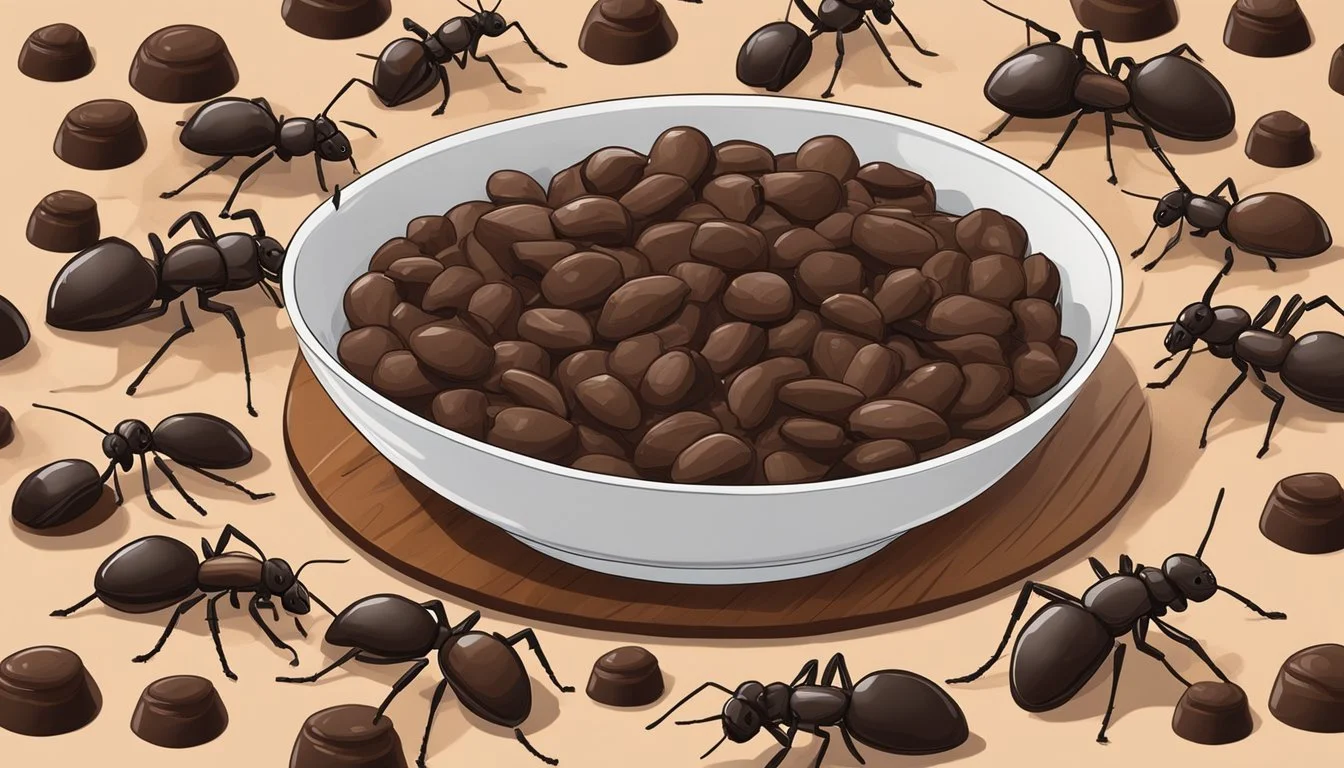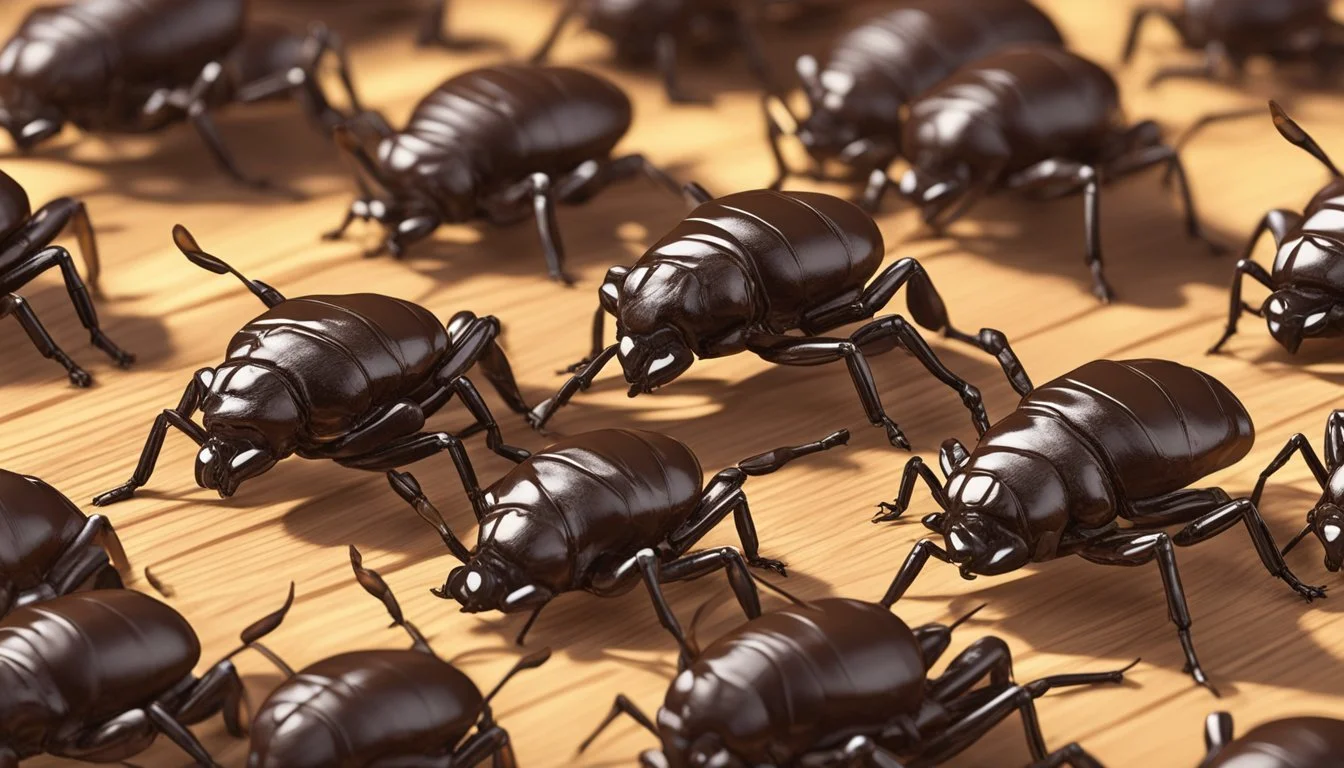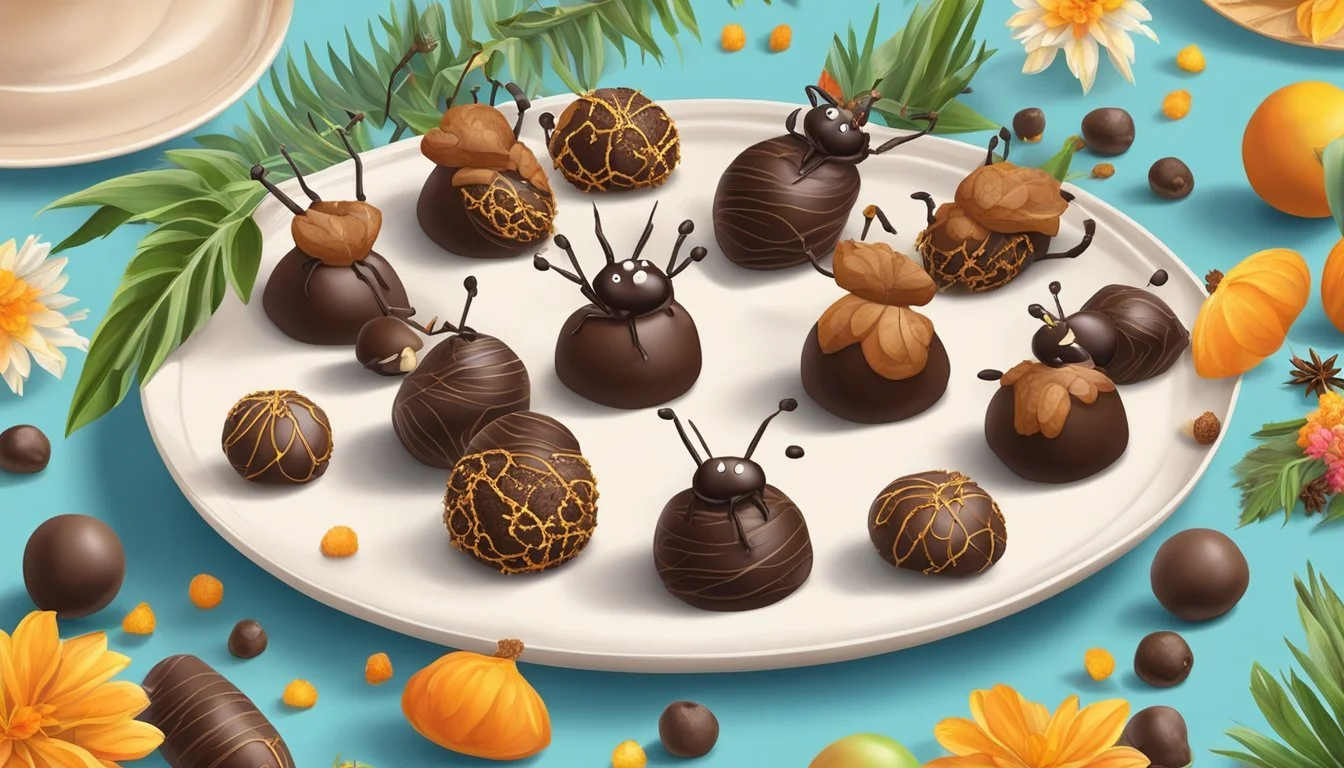Chocolate-Covered Ants
A Protein-Rich Delicacy Blending Sweetness and Crunch
Chocolate (What wine goes well with chocolate?)-covered ants are emerging as an intriguing confectionery that combines the distinctive crunch of edible insects with the familiar sweetness of chocolate. This fusion offers a novel taste experience and is also a source of protein, appealing to both adventurous foodies and those looking to diversify their protein intake. As the culinary world becomes increasingly experimental, chocolate-covered ants are gaining popularity across various cultures where the concept of entomophagy – the consumption of insects as food – is being embraced as both sustainable and nutritious.
The concept isn't entirely new; many cultures have incorporated insects into their diets for centuries due to their high protein content and availability. The addition of chocolate enveloping the ants adds a layer of rich flavor that can satisfy a sweet tooth while alleviating some of the hesitancy associated with consuming insects. The result is a crunchy snack that is not only a talking point for its novelty but also stands as a testament to the versatility of chocolate as a pairing with unconventional ingredients.
Origins and Popularity
Chocolate-covered ants offer a combination of sweet and savory flavors, tracing their origins to ancient traditions. They provide a unique source of protein and have experienced a surge in popularity as a novelty snack.
Cultural Significance
Historically, chocolate-covered ants are steeped in tradition, often consumed by indigenous cultures such as the Maya and Aztec civilizations. These societies revered ants as a source of nutrients and protein, incorporating them into various aspects of their culture, including family events and religious ceremonies. The practice of coating ants in chocolate enhanced their flavor, making them a more appealing delicacy.
Growth of the Trend
In the mid-20th century, chocolate-covered ants gained popularity in Western society as a Halloween and wedding treat, symbolizing both novelty and a nod to exotic traditions. As awareness of their health benefits increased, so did their acceptance as a snack option. This trend aligns with a growing interest in alternative protein sources that offer essential nutrients.
Ingredients and Types
When crafting chocolate-covered ants, the recipe primarily hinges on two essential components: the chocolate selected for coating and the type of ants used. A variety of additional flavors and textures can be introduced to enhance the sweet and savory experience.
Type of Chocolate
Dark Chocolate: Rich in flavor and contains less sugar, making it a heartier option for coating.
Milk Chocolate: Sweeter and creamier, milk chocolate lends a more indulgent taste to the treat.
White Chocolate: Offers a sweet and buttery flavor, often paired with other flavor enhancements.
Chocolates are melted, often with a small addition of oil to achieve a smoother texture, avoiding direct contact with water to prevent seizing.
Variety of Ants
Black Ants: Typically selected for their mild taste and crunchy texture; avoid red ants as they have a spicy kick.
Ants must be clean and processed, which includes removing any inedible parts, before being coated in chocolate.
Additional Flavors and Textures
Coconut: Adds a tropical hint and chewiness when sprinkled on freshly coated ants.
Almonds and Other Crushed Nuts: (What wine goes well with nuts?) Provide an extra crunch and nuttiness.
Peanut Butter: Infusing or drizzling it over chocolate offers a creamy, salty-sweet dynamic.
Raisins and Dried Fruit: Introduce natural sweetness and chewy bites.
Sea Salt: A sprinkle can heighten the flavor profile with a savory edge.
Optional ingredients such as the above are used to create unique flavor combinations that cater to different palates.
Health and Nutritional Information
When considering chocolate-covered ants, one must examine their health and nutritional profile, specifically focusing on protein content and potential health benefits these edible insects may offer. They may provide a unique combination of nutrients in a keto-friendly package.
Protein Content
Chocolate-covered ants are an intriguing source of protein. Ants themselves are rich in protein, which is crucial for muscle repair and growth. When covered in chocolate, the protein content can vary, but typically, you can expect a substantial amount of protein per serving. For example, a single serving might contain:
Protein: Approximately 6 grams
This protein is animal-based, as it comes from the ants, and it complements the small amount of protein found in the chocolate.
Potential Benefits
Aside from their protein content, chocolate-covered ants can offer other nutrients and health benefits. They are low in carbohydrates, which might make them suitable for a keto diet. The ants can also contain other nutrients such as:
Fatty acids: Unsaturated fats that are beneficial for heart health.
Vitamins: Such as B vitamins, which are important for energy metabolism.
While these treats do provide a sweet flavor, the addition of chocolate means that one should consume them in moderation, as chocolate can add sugar and fat to the diet. However, when eaten as part of a balanced diet, chocolate-covered ants can be an interesting and nutritious option.
Preparing Chocolate-Covered Ants
Chocolate-covered ants offer a unique combination of sweet and crunchy flavors, paired with a high protein content. Perfecting the preparation process ensures a delightful snack that's both unconventional and indulgent.
Step-by-Step Recipe
Ingredients:
Edible ants
High-quality chocolate
Oil (optional)
Honey (optional)
Directions:
Start by sourcing edible ants, ensuring they are safe for consumption.
Gently cleanse the ants with water to remove any debris. Pat them dry.
If desired, season the ants with a small amount of honey for added sweetness.
Melt the chocolate using a double boiler or microwave in 30-second bursts until it is smooth and shiny.
Optional: Add a drop of oil to the chocolate to achieve a glossy chocolate coating.
Using tweezers, dip each ant into the melted chocolate, ensuring a full coating.
Place the coated ants onto a sheet of waxed paper, allowing them to drain and cool.
Once set, the chocolate-covered ants are ready to be enjoyed.
Storage Recommendations
Short-Term Storage:
Store in an airtight container in a cool, dry place.
They can be kept at room temperature if it is not too warm.
Long-Term Storage:
For extended preservation, refrigerate the chocolate-covered ants in an airtight container.
Chocolate can absorb odors; keep away from strongly scented foods.
Serving and Presentation
When it comes to serving chocolate-covered ants, presentation is key to entice the sweet tooth while highlighting the unique crunchy texture of this protein-packed treat.
Creative Serving Ideas
For an eye-catching display, consider these suggestions:
On a Fruit Platter: Arrange the chocolate-covered ants alongside a variety of fresh fruits like strawberries and apple slices for a sweet and healthy contrast.
Festive Toppings: Embellish the chocolate-covered ants with festive sprinkles or a dusting of powdered sugar to enhance their visual appeal for special occasions.
Elegant Garnish: Adorn cakes or cupcakes with a modest scattering of these delicacies, particularly striking on a layer of white frosting for contrast.
Pairings and Occasions
Choosing the right moment and complement for chocolate-covered ants can elevate the experience:
With Yogurt: For a breakfast twist, sprinkle them over a bowl of yogurt to introduce a delightful crunch.
Wedding Favours: Encased in miniature boxes, chocolate-covered ants can serve as a daring and memorable treat for wedding guests.
Halloween Treats: They are an excellent addition to a Halloween party spread, intriguing guests with their spooky yet indulgent nature.
Family Gatherings: Introducing them during family events can spark conversation and offer a unique tasting experience.
Variations and Customizations
Chocolate-covered ants offer a unique sweet and crunchy experience with the added benefit of protein. Customization options allow consumers to align this exotic delicacy to their own taste preferences.
DIY Flavor Combinations
Diverse flavor combinations can be created by utilizing different types of chocolate, such as milk chocolate, dark chocolate, or white chocolate. One can easily adapt the recipe to suit their palate:
Milk Chocolate Ants: A classic choice that provides a creamy and sweet flavor which complements the natural crunchiness of ants.
Dark Chocolate Ants: Offers a less sweet but more intense cocoa experience, ideal for those who prefer a richer taste and the health benefits of dark chocolate.
White Chocolate Ants: Provides a sweeter and buttery flavor profile, adding a contrasting softness to the ants' texture.
Incorporating dried fruit into the chocolate coating can introduce additional flavor dimensions and visual appeal. For instance:
Raisin-Drizzled Ants: They can be coated in chocolate and then drizzled with a thin line of alternate chocolate flavor or topped with small pieces of dried fruit.
Berry Chocolate Ants: A sprinkling of finely chopped dried berries can add tartness and complement the inherent sweetness of white or milk chocolate.
One can also experiment with a chocolate drizzle technique to create multi-layered flavor profiles:
Chocolate Type: Milk Chocolate, Drizzle Type: Dark Chocolate, Description: Adds depth to the sweetness with a hint of bitterness.
Chocolate Type: Dark Chocolate, Drizzle Type: White Chocolate, Description: Creates a stark flavor contrast and visual accent.
Chocolate Type: White Chocolate, Drizzle Type: Milk Chocolate, Description: Balances the sweetness with a richer cocoa element.
Each of these variations allows individuals to explore a wide range of flavors and textures, personalizing their chocolate-covered ants to their liking.
Safety and Allergies
When considering the consumption of chocolate-covered ants, safety and awareness of potential allergies are paramount. Consumers should be informed about the content of allergens and the conditions under which these treats are produced.
Allergen Information
Protein Content: Chocolate-covered ants are high in protein, which is beneficial for health, but they may pose a risk for individuals with protein-specific allergies.
Insect Allergies: Individuals with a history of insect allergies should approach chocolate-covered ants with caution, as allergic reactions may occur.
Production Facilities: Facilities where chocolate-covered ants are produced may also handle common allergens such as nuts, dairy, and gluten, which could lead to cross-contamination.
Kosher Certification: For those adhering to Kosher dietary laws, it's important to verify if the chocolate-covered ants have received Kosher certification, as the dietary restrictions consider insects non-Kosher.
Making Chocolate-Covered Ants at Home
Creating chocolate-covered ants at home offers a unique opportunity to experiment with a high-protein snack that is both sweet and crunchy. This section provides insight on crafting these treats yourself and helpful hints to ensure success.
Homemade Versus Store-Bought
When it comes to chocolate-covered ants, enthusiasts can choose between purchasing pre-made delicacies or embracing the satisfaction of making them from scratch. The homemade route allows for customization of the chocolate coating, potentially leading to a fresher taste and a more personal touch. Commercially available chocolate-covered ants may not offer the same level of freshness, and their quality will vary by brand. For those keen on DIY, a homemade batch ensures that only the best ingredients are used, and the recipe can be adjusted to personal preference.
Tips and Tricks
Here are some specific tips to streamline the process and enhance the quality of homemade chocolate-covered ants:
Preparation of Ants:
Source edible ants that are safe for consumption rather than catching wild ants.
If using live ants, ensure that they are cleanly and humanely dispatched by placing them in a freezer for a short time.
Creating the Chocolate Coating:
Melt the chocolate slowly using a double boiler or microwave on 50 percent power, stirring occasionally to prevent burning. Adding a small amount of oil can create a smoother consistency.
Coating Process:
Use tweezers to dip each ant into the melted chocolate, covering them completely.
Gently tap off excess chocolate and lay the coated ants on waxed paper to set.
Storage:
Once the chocolate hardens, store the chocolate-covered ants in an airtight container in a cool, dry place to maintain their crunchy texture.
By following these guidelines, one can craft homemade chocolate-covered ants that are a conversational piece and a novel way to consume protein.
Cultural and Seasonal Trends
Chocolate-covered ants represent a fascinating intersection of cultural tradition and modern culinary experimentation. They offer a unique taste experience that is protein-packed and delectably crunchy, catering to a sweet tooth with an adventurous twist.
Halloween Specials
Halloween has evolved into a season not just for candy corn but for novel treats that elicit both intrigue and delight. Chocolate-covered ants fall perfectly into this category. Festive sprinkles often adorn these tiny delicacies, adding a playful touch to their presentation. Families seeking a blend of the traditional Halloween spookiness with an exotic twist are increasingly considering these edibles as part of their holiday festivities.
Weddings and Celebrations
When it comes to weddings and celebrations, chocolate-covered ants are emerging as an exotic choice for couples desiring to set their events apart. They have found a place in boutique wedding candy bars, symbolizing the blending of two distinct families into a unique and harmonious new entity. This treat serves as both a conversation starter and a testament to the couple’s taste for the unconventional.









